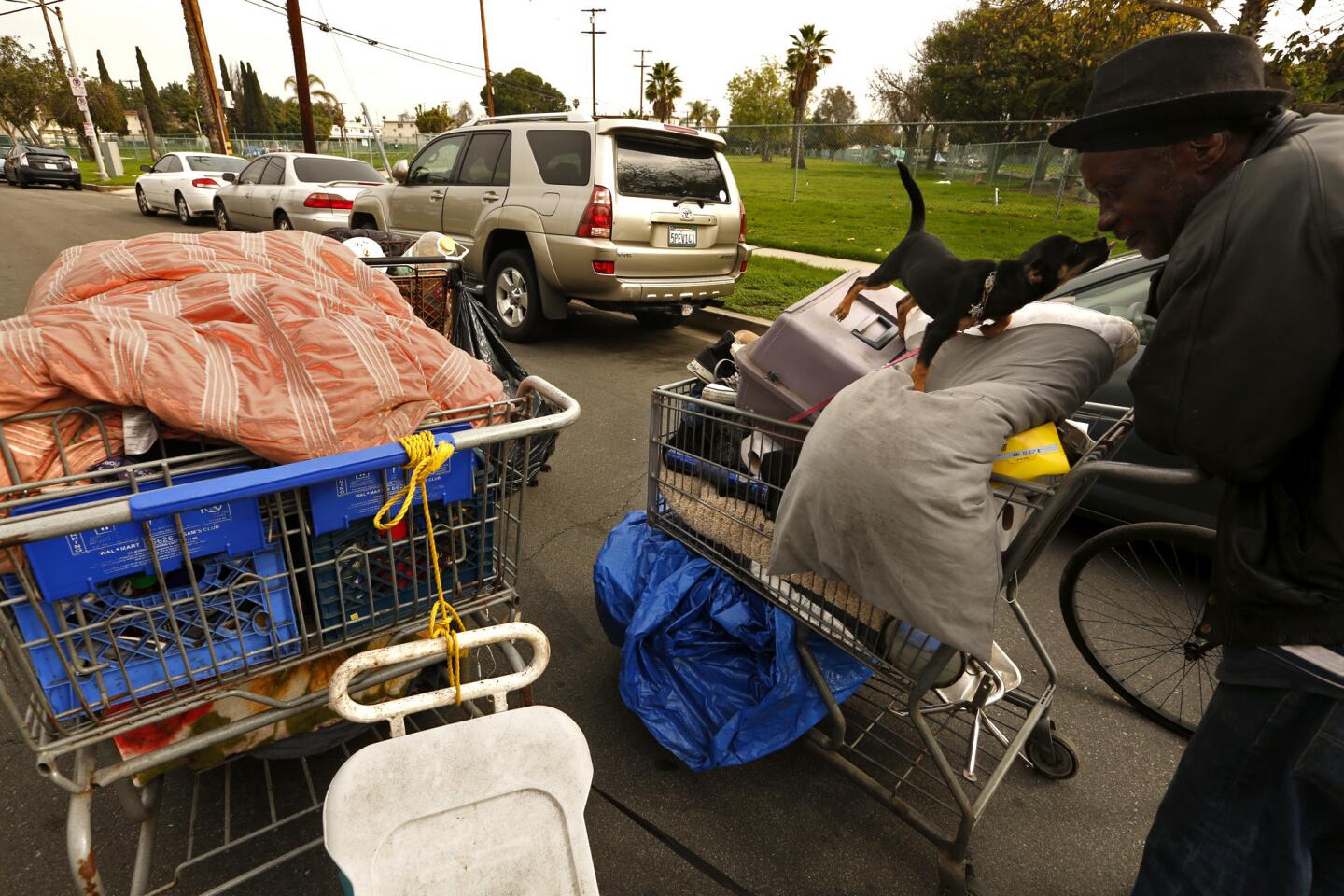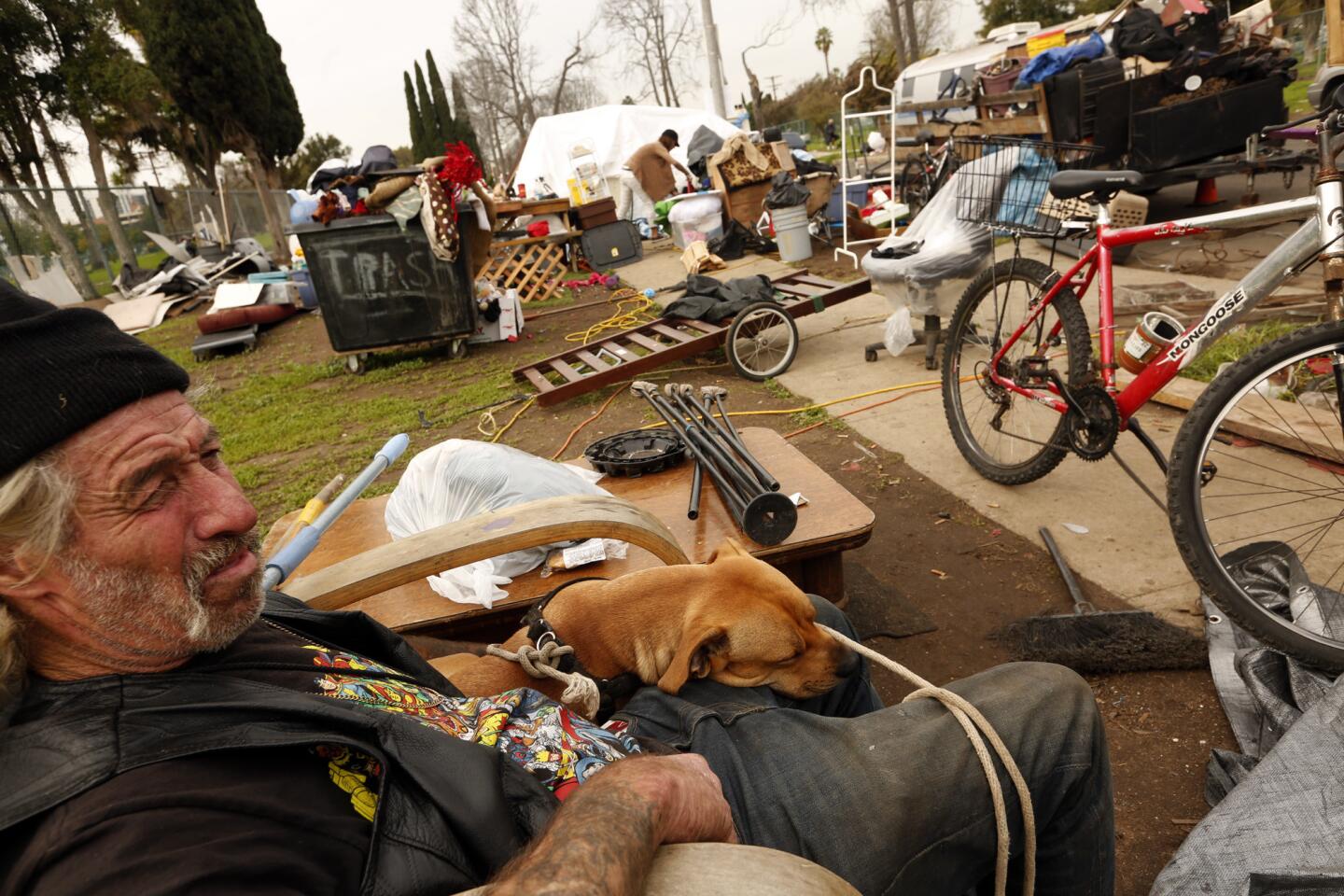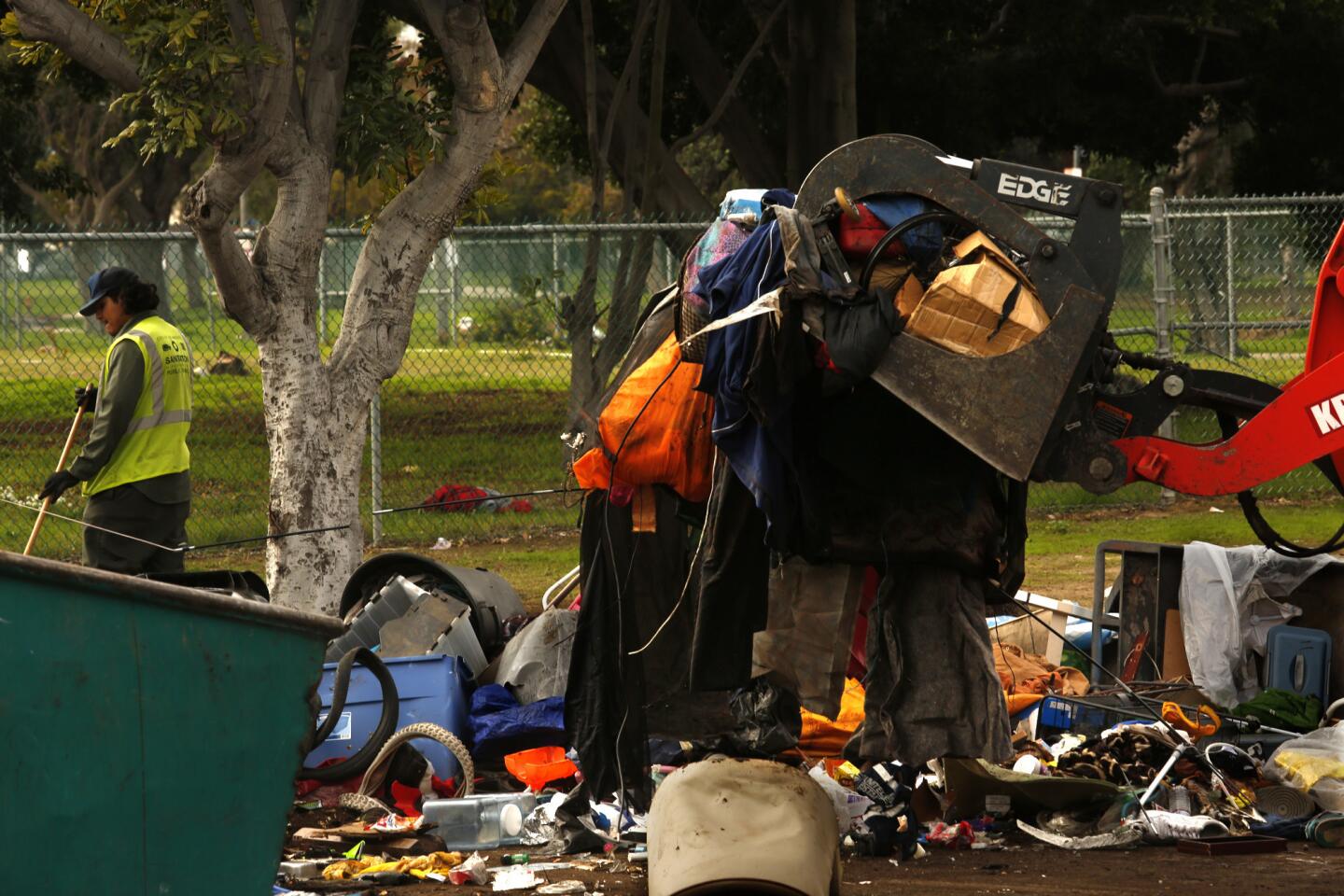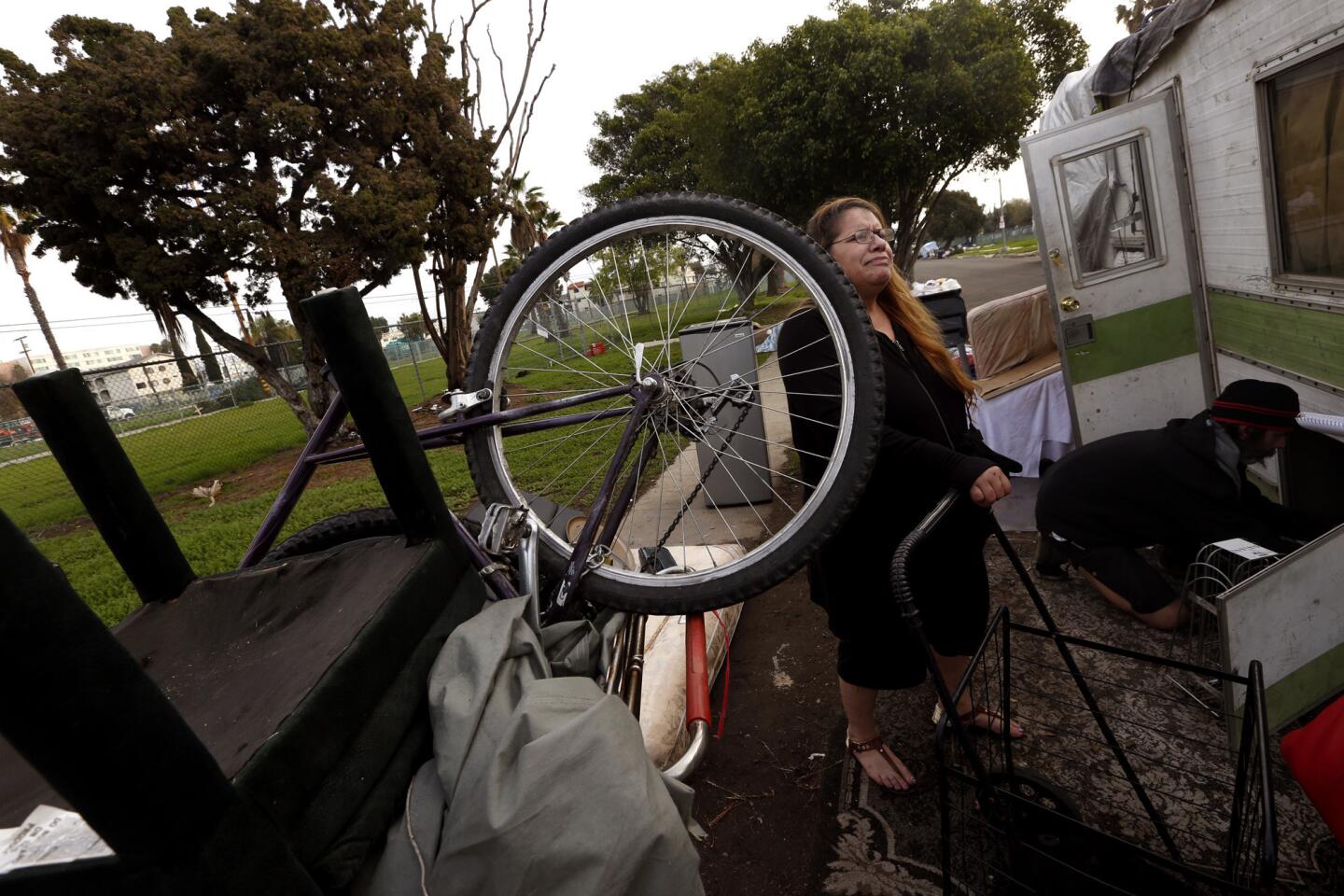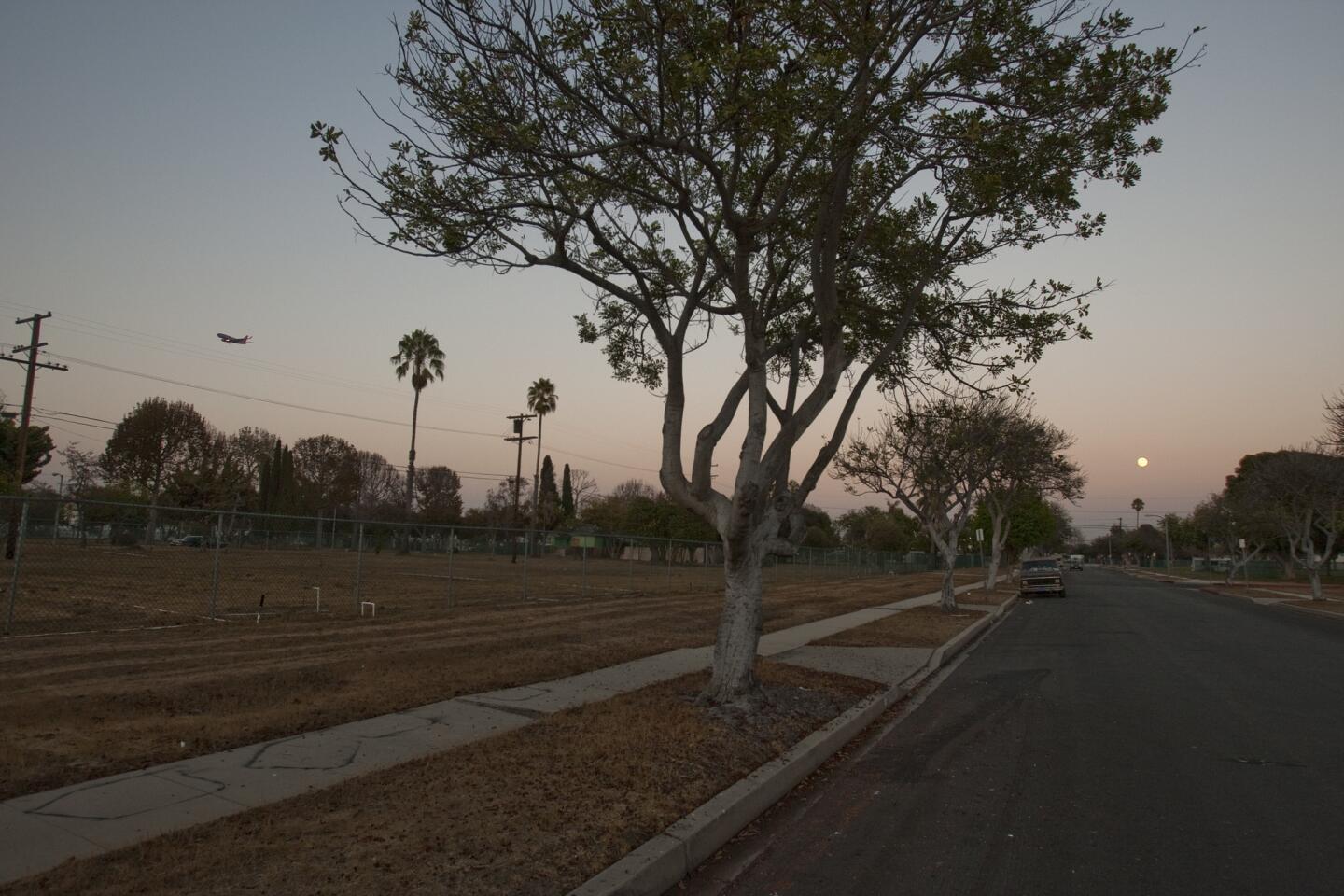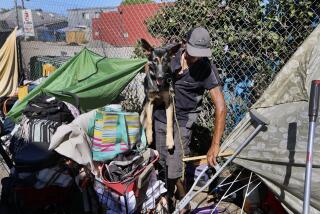‘There’s no place else ... that we can run to’: Residents of huge homeless camp are asked to clear out to make way for LAX project

A homeless camp stands in the way of Los Angeles International Airport’s planned rental car facility, parking areas and transportation hub.
- Share via
When Bill Clinton was president, the operator of Los Angeles International Airport began buying up and razing Manchester Square, a cozy 1950s housing tract located under the flight path.
The buyouts took care of the residents’ noise complaints but left behind an eerily suburban ghost town of lush green lawns, sans houses, immediately north of the hotels on West Century Boulevard.
LAX is finally preparing to develop a rental car facility, parking areas and a transportation hub in the 20 square blocks of Manchester Square as part of its modernization plan.
But as homelessness rose during the last three years, and parking crackdowns drove campers and RVs out of nearby Venice and other communities, the neighborhood became filled with one of Los Angeles’ largest collections of homeless camps outside the 50 square blocks of skid row.
The squatters’ village of tents, peeling campers, lopsided RVs and cars is home to 200 to 350 people. The airport, which has spent $437 million buying out residents and plans to spend an additional $1 billion for property, won’t pay to relocate the homeless occupants.
Mary Grady, a spokeswoman for Los Angeles World Airports, said airport revenue can be spent only on aviation-related facilities at LAX, such as passenger terminals, runways and taxiways.
Airport officials have said construction preparation for several new projects in Manchester Square could start as soon as January 2018, although no deadline has been set.
To help the homeless people move on, the city and county of Los Angeles set up a multi-agency task force a year ago. But with the clock running down, only six people have found permanent housing, and others say they have nowhere to go.
“This is the new homeless,” said Sherri Kelly, 54, who shares a camper at the square with her husband. “Once you’re out here, it’s nearly impossible to come in. There’s no place else to park or that we can run to.”
Officials said they are confident they can relocate the squatters before the airport project, which is in environmental review, begins. The task force includes specially trained airport police officers, city street services and sanitation departments, and mental health and outreach teams.
“No entity can be singularly responsible for tackling the homelessness crisis. If we are going to lift up homeless Angelenos and help them find safe places to sleep, we need an all-hands-on-deck approach,” Mayor Eric Garcetti’s press secretary, George Kivork, said in an email.
Some in Westchester fear the effort will trigger a mass expulsion from Manchester Square.
“I don’t want them to start forcing these people out. Where are they going to go?” said Garrett Smith, a director on the Neighborhood Council of Westchester/Playa.
I lived a normal life. We’re not criminals. We’re middle-class Americans.
— Sherri Kelly, homeless person, Manchester Square
How this nest of postwar domesticity became a textbook case of urban blight is a story of politicians’ shifting visions and legal and economic setbacks.
Manchester Square sprang up after World War II to house aerospace workers, teachers and pilots. As noise complaints grew, the airport decided on a voluntary buyout plan, but home purchases fell off after the 9/11 terrorist attacks and again during the Great Recession.
For years, no proposals to reuse the property were finalized. Under Mayor Richard Riordan, a cargo facility was floated, and Mayor James Hahn proposed a giant transportation/check-in center, part of an LAX master plan that ended up in court.
Airport officials now plan to use the property for a consolidated car rental facility, additional parking and a public transportation hub. The owners of six houses and 31 apartment buildings are the last holdouts, Grady said.
Some of the squatters who moved in said they lost their homes in nearby communities, including Hawthorne and Redondo Beach, because of various life crises, disabilities and lost jobs.
Carlos Alvarez, dean of the Bright Star Secondary Charter Academy in Manchester Square, said a group also arrived from Venice, where homelessness dropped about 25% from 2015 to 2016 after a crackdown on occupied campers.
“We always had motor homes on 99th Street, but two years ago, we came back from summer break and it had just exploded,” Alvarez said.
Renters blame the camps for car break-ins, vandalism and people sleeping in their laundry rooms. Police said most of the crime is petty. Substance abuse and mental illness is “a huge factor,” said Anika Simpson, a nurse with the county mental health evaluation team.
The bare lawns are fenced off, so the homeless people sleep in vehicles or camp out on grassy parkways. Regular city cleanups send them scurrying with mattresses lashed to shopping carts as men in hazmat suits spray the turf with disinfectant.
Alvarez said the police escort schoolchildren past the camps. The homeless are largely cooperative, he said. “At 3 p.m., they go inside their tents.”
But some are not as amenable to the task force’s ideas of where they should move.
“I’m not working on housing. Housing is negative equity. It costs money, and if you take the cash allowance and food stamps, that’s not enough,” said a two-year resident who gave his name only as Frank R. “I make that recycling.”
As for shelters, he added, “I’m a drinker and you can’t do that. Where’s my cocktail in the shelter?”
Other homeless people say they live off disability payments or low-wage jobs and can’t afford L.A.’s soaring rents. Kelly, who once lived in a Manchester Square apartment, said she was evicted from her home in Hawthorne after her accounts were frozen in a messy identity theft case.
“I lived a normal life,” she said. “We’re not criminals. We’re middle-class Americans.”
Smith, of the Neighborhood Council, said the airport owes the homeless people a “soft landing.” He suggested they be allowed to move their motor homes to an employee RV colony the airport oversees at one of its parking lots.
Grady said the colony was for workers forced to relocate after 9/11. It is winding down through attrition, and the parking lot will be leased later this year, she added.
Kelly said she can’t understand why the city or airport can’t bring in portable restrooms or let camp residents stay in the half-abandoned apartment buildings.
“What I feel strongest about is all the empty apartments, and us all sitting here in the rain,” Kelly said. “A lot of people out here are sick and disabled. It gets cold, and we get hungry.”
Victor Hinderliter, associate director at the Los Angeles Homeless Services Authority, said he believes the city-county team can find bridge or crisis housing for the homeless. The city has indicated it plans to allow them to park in church and synagogue lots later this year.
On Monday, however, police began enforcing a new city law barring people from living in vehicles near homes, parks and schools.
“We have some time,” Hinderliter said.
Kelly said the task force’s offers to expedite housing for her have gone nowhere. “Nobody sees it through to the end,” she added. “Maybe the housing people tried to call. We don’t have phone service.”
Before she lost service, Kelly said an eviction-prevention counselor returned her call — after she’d been thrown out in the street.
“This isn’t our problem,” said Alvarez, the charter school dean. “It’s the city’s problem.”
Twitter: @geholland
ALSO
L.A., Orange counties are home to 1 million immigrants here illegally, analysis shows
L.A.’s mayor wants to lower the city’s temperature. These scientists are figuring out how to do it
More to Read
Sign up for Essential California
The most important California stories and recommendations in your inbox every morning.
You may occasionally receive promotional content from the Los Angeles Times.
